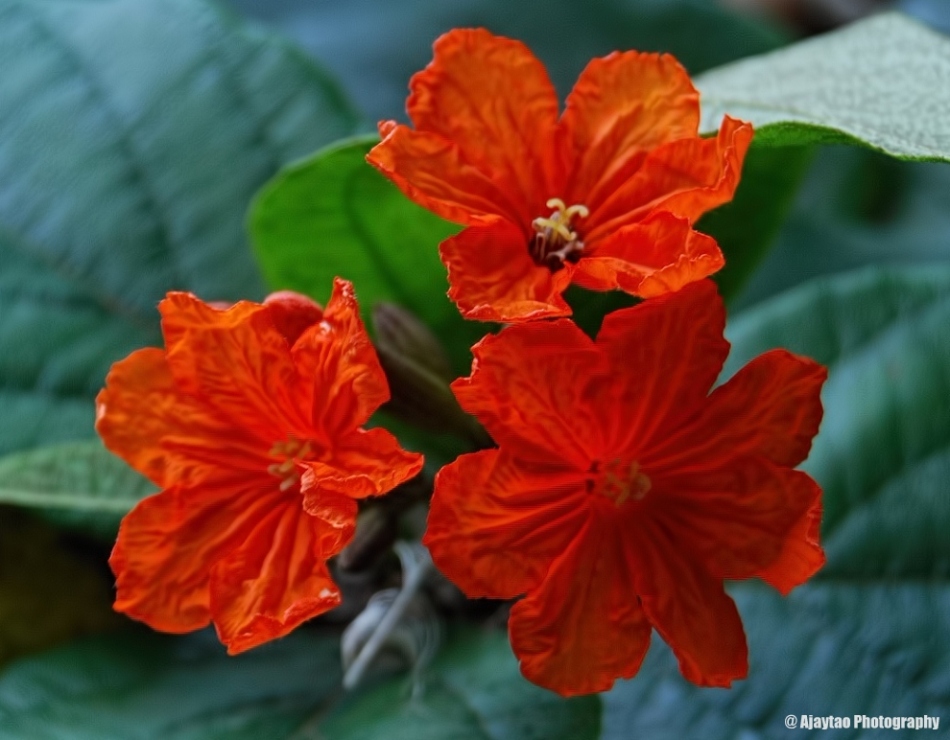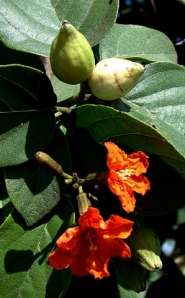Cordia Sebestena – Scarlet Cordia – Ajaytao
Common name: Orange Geiger Tree, Scarlet Cordia, Sebestena Plum Tree,, Geiger Tree, Sea Trumpet, Spanish Cordia, Ziricote, Texas Olive, Geranium tree, large-leaf geiger tree, bois râpe – French, Scharlach-Kordie –German, Sebestenenbaum – German, Sebesteira-verdadeira – Portuguese, Anacahuita – Spanish, Anaconda – Spanish, siricote blanco
Hindi: लाल लसॊड़ा Lal Lasora, Bohari
Bengali: Kamla buhal, Raktarag
Botanical name: Cordia Sebestena
Family: Boraginaceae (Forget-me-not family)
Subfamily: Cordioideae, Cordiaceae Ehretiaceae
Genus: Cordia
Species: C. sebestena
Cordia sebestena is a species of flowering plant in the borage family, Boraginaceae, that is native to the American tropics. and is cultivated in Southeastern U.S.A.: Florida, Southern Mexico – Quintana Roo, Yucatan, Caribbean: Bahamas; Cuba; Dominican Republic; Haiti; Jamaica, Mesoamerica: Belize; Honduras; Panama, India and many tropical and subtropical countries of the world. Geiger Tree (after Key West wrecker John Geiger) in Florida.
Scarlet cordia is a small shapely tree which grows up to be 25 feet tall and as wide. It is native to the northern coast of South America. This plant, on account of its large tubular scarlet flowers, is one of the most beautiful of the West Indian trees. This dense, rounded, evergreen native tree grows slowly to a height of 25 feet with an equal spread and can develop a trunk 12 inches thick. The large, seven-inch-long, stiff, dark green leaves are rough and hairy, feeling much like sandpaper. Appearing throughout the year, but especially in spring and summer, are dark orange, two-inch-wide flowers which appear in clusters at branch tips. The splendid flowers are followed by one to two-inch-long, pear-shaped fruits, which have a pleasant fragrance but are not particularly tasty.
Cordia (which means late) was named for father and son German botanists/pharmacists/physicians Euricius Cordus (1486-1535) and Valarius Cordus (1515-1544.) Euricius (Heinrich in German) was a professor and the 13th son of a farmer named Urban Solden. As number 13 little Heinrich was called the “late one” or in Latin Cordu. He kept the name as a last name when he Latinized his name as many educated people of that age did, going from Heinrich Urban Solden to Euricius Codus. His son, Valarius Codus, died at 29 of malaria while in Rome but had already established himself as a intellectual heavyweight of his age. His posthumous publications bolstered his reputation even more. Sebestena if from Sebesten, a name given to a related tree with similar fruit.
Cordia sebestena is widely planted throughout the tropics and subtropics as an ornamental plant in gardens because of its flowers. It has dark green, oval shaped leaves, and grows oval shaped fruits that are edible, but not flavorful. Cordia sebestena tolerates drought but not frost.
Flower color: orange
Flower characteristics: very showy
Fruit shape: oval
Fruit length: 1 to 3 inches
Fruit covering: dry or hard
Fruit color: white/gray, green
Fruit characteristics: does not attract wildlife; showy; fruit, leaves a litter problem.
Geiger-Tree is quite salt- and brackish-water tolerant, making it ideal for use in coastal landscapes as a free-standing specimen, patio or framing tree. Most specimens are seen as multitrunked and low-branching but nurseries can produce single-trunked trees suitable for downtown and parking lots. It has been used as a street tree in some communities but drops leaves as a drought-avoidance strategy in prolonged dry spells. According to legend, the common name was bestowed by Audubon in commemoration of John Geiger, a Key West pilot and wrecker of the 19th century and is now used quite universally as the common name for this excellent Florida native tree.
Growing in full sun to partial shade, Geiger-Tree is tolerant of light, sandy, alkaline soils and salt-spray. It is highly recommended for seaside plantings. Do not plant where there is the slightest danger of frost.
Cordia boissieri is frost-resistant (tolerating temperatures in the high 20’s) and has stunning white flowers with yellow centers.
Propagation is by seeds or layering.
The Cordia sebestena has been planted through much of the warm world for its scarlet flowers and edible white drupes. While the fruits are edible their smell is better than they taste. They are also fibrous. The tree also has a long medicinal history. Where it is from is a debate, from Cuba to the West Indies to South America. The teapot tempest rages on. The fruit of the C. alliodora is also edible. Fruit is juicy and edible raw (not the seeds) Cooking improves the flavor.
Pests
Mites, scales, and caterpillars will occasionally attack Geiger-Tree. The geiger beetle defoliates the tree upon occasion but the trees generally grow out of it and do fine. The problem can be locally troublesome.
Medicinal Uses
Essential oils have been reported to possess various medicinal properties in folkloric medical practices. Their application in modern medicine has also increased recently. Syrup of the bark, flowers, or fruit is taken for coughs and bronchial ailments. Teas made from the flowers are used to treat venereal disease. The tree’s sap is applied to wounds. Leaves washed in warm water or dressed with oil are used as poultices for headaches and sprains. Unripe fruit are emetic.
The chemical composition of the essential oil from the stem bark of Cordia sebestena obtained by hydrodistillation was determined using gas chromatography–mass spectrometry and analyzed for its free radical scavenging potential using the 1,1-diphenyl-2-picrylhydrazyl (DPPH) assay.
A total of nineteen compounds were identified with the major compounds being 9-octadecene (E) (20.26%), 5-octadecene (E) (18.68%), 9-eicosene (13.99%), cyclopropane, nonyl (12.42%), 3-eicosene (E) (7.29%), phenol, 2,4-bis(1,1-dimethylethyl) (4.71%), 1-nonadecene (3.17%), 7,9-di-tert-butyl-1-oxaspiro(4,5)deca-6,9-diene-2,8-dione (2.70%), and 2,6-diisopropylnaphthalene (2.17%). The DPPH radical scavenging potential of the oil was higher than the standard, butylated hydroxyanisole, with IC50 of 2.00 ± 0.31 μg/mL and 47.00 ± 1.27 μg/mL, respectively. At 50 μg/mL, the antioxidant potential of the butylated hydroxyanisole was 75% whereas the oil had 82% free radical scavenging activity. Several hydrocarbons contained in the essential oil may have contributed to the aromatic and antioxidant properties of the plant. The hydrocarbons could be useful for chemotaxonomic characterization of Cordia sebestena.
The essential oil may be further explored for its potential as an antioxidant contributor in food and phytotherapeutic medicine.
Ajaytao Photography
This entry was posted on May 15, 2014 by Ajaytao2010. It was filed under Flowers and was tagged with Ajaytao, Ajaytao Photography, Anacahuita – Spanish, Anaconda – Spanish, Art Photography, Bark, Beautiful, bois râpe – French, Botanical, Botanical name: Cordia Sebestena, Botany, Colorful Flowers, Cordia Sebestena, Cordiaceae Ehretiaceae, Family: Boraginaceae, Flowers, Gardens, Geiger Tree, Genus: Cordia, Geranium tree, High Resolution Pictures, HQ Pics, Hues of Nature, large-leaf geiger tree, Leaf, Leaves, Nature, Nature Photography, Natures Beauty, Orange Geiger Tree, Photography, Plants, Scarlet Cordia, Scharlach-Kordie –German, Sea Trumpet, Sebesteira-verdadeira – Portuguese, Sebestena Plum Tree, Sebestenenbaum – German, Shades of Nature, Shrubs, siricote blanco, Spanish Cordia, Species: C. sebestena, Subfamily: Cordioideae, Texas Olive, Tree, Trees, Ziricote.





My favorite color orange! I’ve never seen this before but now I have! 🙂 Beautiful!
LikeLike
May 15, 2014 at 11:21 pm
oh thank you 🙂
LikeLike
May 15, 2014 at 11:22 pm
Thanks for your visit to my blog. I find your blog very interesting.I’m no Botanist, but shoot flowers because I find them beautiful and interesting. And support in the poem what your about.
LikeLike
May 15, 2014 at 11:43 pm
Reblogged this on Oyia Brown.
LikeLike
May 16, 2014 at 4:54 pm
Nature is life, I love nature.
LikeLike
May 19, 2014 at 12:02 pm
thank you dear
I also love it very much 🙂
LikeLike
May 19, 2014 at 12:04 pm
🙂
LikeLike
May 19, 2014 at 12:18 pm
🙂 🙂
LikeLike
May 19, 2014 at 12:21 pm
Pretty 🙂
LikeLike
May 19, 2014 at 10:08 pm
Oh thank you dear 🙂
LikeLike
May 19, 2014 at 10:14 pm
you’re welcome 🙂
LikeLike
May 20, 2014 at 12:52 am
🙂 🙂
LikeLike
May 20, 2014 at 12:53 am
Reblogged this on Ajaytao 2010 and commented:
Cordia Sebestena – Scarlet Cordia – Ajaytao
LikeLike
May 23, 2014 at 1:45 pm
Ein sehr hübsche Blume und eine schöne Farbe.
LG Mathilda ❤
LikeLike
May 23, 2014 at 5:03 pm
Thank you so much dear 🙂 🙂
LikeLike
May 23, 2014 at 5:12 pm
Reblogged this on Amazing Fine Art.
LikeLike
May 23, 2014 at 8:45 pm
Your work is extensive and so beautiful. This is an amazing flowering plant.
LikeLike
May 30, 2014 at 2:42 am
thank you so much dear 🙂
LikeLike
May 30, 2014 at 6:35 am